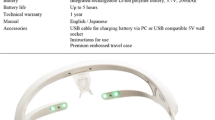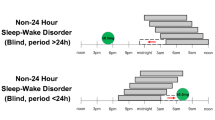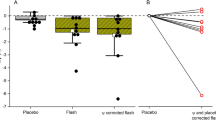Abstract
Introduction
Melatonin is recommended for hastening adaptation to phase shift, but there is little information on appropriate formulations.
Materials and methods
We evaluated the efficacy of three melatonin formulations for circadian phase advance and delay: (a) 3 mg regular release (RR), (b) 3 mg sustained release (SR), and (c) 3 mg surge-sustained release (SSR; consisting of 1 mg RR and 2 mg SR). Circadian phase was assessed by salivary melatonin dim light melatonin onset (DLMO) or offset (MelOff) using thresholds of (1) 1.0 pg/ml and (2) mean baseline + 2 standard deviations (BL + 2SD). Subjects spent from Tuesday evenings until Thursday in the laboratory. Melatonin (or placebo) was administered at 1600 hours (phase advance) Wednesday, with DLMO assessment on Tuesday and Thursday and at 0600 hours (phase delay) Wednesday, with DLMO assessment Tuesday, Wednesday, and MelOff Thursday morning. Phase advances using the 1.0 pg/ml DLMO were as follows: placebo, 0.73 h; RR, 1.23 h (p < 0.003); SR, 1.44 h (p < 0.0002); SSR, 1.16 h (p < 0.012), with no difference between formulations.
Results and discussion
Similar but smaller phase advances were found with BL + 2SD. Using MelOff, posttreatment phase position for the RR formulation was delayed compared to placebo by 1.12 h (p < 0.012), 1.0 pg/ml, and 0.75 h (p < 0.036), BL+2SD. Phase shifts for the SR and SSR conditions could not be determined due to persistent high melatonin levels during sampling times. Similar phase advances were induced by all formulations, and slow clearance of slow release preparations impeded the determination of phase delays.
Conclusion
Appropriately timed 0.5 mg melatonin doses may avoid these problems.




Similar content being viewed by others
References
Arendt J (2009) Managing jet lag: some of the problems and possible new solutions. Sleep Med Rev 13:249–256
Arendt J, Skene DJ (2005) Melatonin as a chronobiotic. Sleep Med Rev 9:25–39
Arendt J, Bojkowski C, Folkard S, Franey C, Minors DS, Waterhouse JM, Wever RA, Wildgruber C, Wright J (1985) Some effects of melatonin and the control of its secretion in man. In: Evered D, Clark S (eds) Ciba Foundation Symposium 117: photo periodism, melatonin and the pineal. Pitman, London, pp 266–283
Arendt J, Aldhous M, Marks V (1986) Alleviation of jet lag by melatonin: preliminary results of controlled double blind trial. Br Med J (Clin Res Ed) 292:1170
Arendt J, Aldhous M, English J, Marks V, Arendt JH (1987) Some effects of jet-lag and their alleviation by melatonin. Ergonomics 30:1379–1393
Benloucif S, Burgess HJ, Klerman EB, Lewy AJ, Middleton B, Murphy PJ, Parry BL, Revell VL (2008) Measuring melatonin in humans. J Clin Sleep Med 4:1542–1551
Burgess HJ, Revell VL, Eastman CI (2008) A three pulse phase response curve to three milligrams of melatonin in humans. J Physiol 586(2):639–647
Cole RJ, Kripke DF, Gruen W, Mullaney DJ, Gillin JC (1992) Automatic sleep/wake identification from wrist activity. Sleep 15:461–469
Deacon S, Arendt J (1995) Melatonin-induced temperature suppression and its acute phase-shifting effects correlate in a dose-dependent manner in humans. Brain Res 688:77–85
Eastman CI, Burgess HJ (2009) How to travel the world without jetlag. Sleep Medicine Clinics 4(2):241–255
Eastman CI, Gazda CJ, Burgess HJ, Crowley SJ, Fogg LF (2005) Advancing circadian rhythms before eastward flight: a strategy to prevent or reduce jet lag. Sleep 28:33–44
Hack LM, Lockley SW, Arendt J, Skene DJ (2003) The effects of low-dose 0.5 mg melatonin on the free-running circadian rhythms of blind subjects. J Biol Rhythms 18:420–429
Horne JA, Ostberg O (1976) A self-assessment questionnaire to determine morningness–eveningness in human circadian rhythms. Int J Chronobiol 4:97–110
Lewy AJ, Sack RL (1989) The dim light melatonin onset as a marker for circadian phase position. Chronobiol Int 6:93–102
Lewy AJ, Sack RL (1996) The role of melatonin and light in the human circadian system. In: Buijs RM, Kalsbeek A, Romijn HJ, Pennartz CMA, Mirmiran M (eds) Progress in brain research, vol. 111. Elsevier Science, Amsterdam
Lewy AJ, Ahmed S, Jackson JM, Sack RL (1992) Melatonin shifts human circadian rhythms according to a phase-response curve. Chronobiol Int 9:380–392
Lewy AJ, Bauer VK, Ahmed S, Thomas KH, Cutler NL, Singer CM, Moffit MT, Sack RL (1998) The human phase response curve (PRC) to melatonin is about 12 h out of phase with the PRC to light. Chronobiol Int 15:71–83
Lewy AJ, Bauer VK, Hasler BP, Kendall AR, Pires ML, Sack RL (2001) Capturing the circadian rhythms of free-running blind people with 0.5 mg melatonin. Brain Res 918:96–100
Lewy AJ, Emens JS, Sack RL, Hasler BP, Bernert RA (2002) Low, but not high, doses of melatonin entrained a free-running blind person with a long circadian period. Chronobiol Int 19:649–658
Morgenthaler TI, Lee-Chiong T, Alessi C, Friedman L, Aurora RN, Boehlecke B, Brown T, Chesson AL Jr, Kapur V, Maganti R, Owens J, Pancer J, Swick TJ, Zak R (2007) Practice parameters for the clinical evaluation and treatment of circadian rhythm sleep disorders. An American Academy of Sleep Medicine report. Sleep 30:1445–1459
Murphy PJ, Myers BL, Badia P (1996) Nonsteroidal anti-inflammatory drugs alter body temperature and suppress melatonin in humans. Physiol Behav 59:133–139
Ozguner F, Koyu A, Cesur G (2005) Active smoking causes oxidative stress and decreases blood melatonin levels. Toxicol Ind Health 21:21–26
Revell VL, Eastman CI (2005) How to trick mother nature into letting you fly around or stay up all night. J Biol Rhythms 20:353–365
Revell VL, Burgess HJ, Gazda CJ, Smith MR, Fogg LF, Eastman CI (2006) Advancing human circadian rhythms with afternoon melatonin and morning intermittent bright light. J Clin Endocrinol Metab 91:54–59
Sharkey KM, Eastman CI (2002) Melatonin phase shifts human circadian rhtyhms in a placebo-controlled simulated night-work study. Am J Physiol Regulatory Integrative Comp Physiol 282:R454–R463
Suhner A, Schlagenhauf P, Johnson R et al (1998) Comparative study to determine the optimal melatonin dosage form for the alleviation of jet lag. Chronobiol Int 15:655–666
Voultsios A, Kennaway DJ, Dawson D (1997) Salivary melatonin as a circadian phase marker: validation and comparison to plasma melatonin. J Biol Rhythms 12:457–466
Waterhouse J, Reilly T, Atkinson G, Edwards B (2007) Jet lag: trends and coping strategies. Lancet 369:1117–1120
Wright HR, Lack LC, Partridge KJ (2001) Light emitting diodes can be used to phase delay the melatonin rhythm. J Pineal Res 31:350–355
Acknowledgments
The views, opinions, and/or findings in this report are those of the authors and should not be construed as an official Defence Research & Development Canada (DRDC), Department of National Defence (DND) Canada, or US Department of Defense (DoD) position, policy or decisions, unless so designated by other official documentation. Citations of commercial organizations and trade names in this report do not constitute an official DRDC, DND Canada, or US DoD endorsement or approval of the products or services of these organizations. Funding for this research was provided by the Canadian Forces.
Author information
Authors and Affiliations
Corresponding author
Rights and permissions
About this article
Cite this article
Paul, M.A., Miller, J.C., Gray, G.W. et al. Melatonin treatment for eastward and westward travel preparation. Psychopharmacology 208, 377–386 (2010). https://doi.org/10.1007/s00213-009-1737-7
Received:
Accepted:
Published:
Issue Date:
DOI: https://doi.org/10.1007/s00213-009-1737-7




